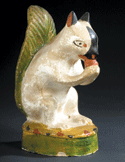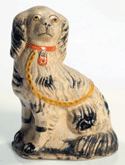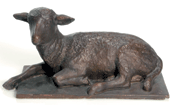|
Cowan's
Corner
Nineteenth Century Chalkware
By Wes Cowan
The origin of American chalkware is generally attributed to the Pennsylvania
Dutch, first appearing in the mid 1800's as a low-cost decorative alternative to
the more expensive English Staffordshire figures. These were often sold door to
door by peddlers as late as 1900 until decorative objects made with more modern
materials and manufacturing methods replaced them around the turn of the
century.
Objects of molded plaster continued to be made as carnival prizes
until the mid-twentieth century, at which time they were replaced by items like
stuffed animals. Many forms of "carnival chalk" were of a different subject
matter and style, like kewpie dolls and ethnic figures that were often
politically incorrect by today's standards. Molded and painted plaster sculpture
are produced to this day, although items recently manufactured are sold as fakes
to deceive collectors or as contemporary "antique" craft items.
The term
"chalkware" is a misnomer because the material used is not actually chalk. The
earliest examples are gypsum, the primary ingredient in plaster of paris. They
were of hollow, thin wall construction, generally molded in two halves that were
cemented together; paint-decorated in watercolor, occasionally in oils. Since
chalkware is molded, many pieces have identical size and form and were able to
retain their uniqueness through individual decorations. Early examples tend to
be gaudy and not naturalistically represented. It would not be uncommon to find
apples painted blue or another inappropriate color. Later examples were painted
in tempera paints and typically are of solid rather than hollow
construction.
Forms most commonly found in chalkware are dogs and cats,
particularly spaniels and poodles, followed by animals such as squirrels,
roosters, doves and parrots. More uncommon forms include lambs, sheep, swans,
deer, lions and pigs. Holiday items and animals with nodding heads are
particularly rare. Fruit and floral mantle garnitures and holiday items are the
highest demand. The watch hutches, unique to nineteenth century life, were
configured similar to a garden shrine. They had a round opening near the top for
hanging a pocket watch to be visible from the front functioning as a mantle
clock. Another scarce figural item is a building with openings for the windows
where a candle could be placed, providing illumination from behind. These were
the forerunners of the plastic buildings illuminated by tiny light bulbs sold
today.
Nineteenth century chalkware exemplifies the definition of "folk" art
in its purest sense. Its manufacture required skill but no formal training. It
represents everyday familiar objects and satisfies a desire for color and beauty
through a simple medium. Chalkware truly was art made by the common folk for
their own enjoyment.
 About the author: Kentucky native Wes Cowan is founder and owner of Cowan's Auctions, Inc. in
Cincinnati, Ohio. An internationally recognized expert in historic Americana, Wes stars in
the PBS television series History Detectives and is a featured appraiser on Antiques
Roadshow. He can be reached via email at info@cowanauctions.com. Article research
by Mike Argenbright. About the author: Kentucky native Wes Cowan is founder and owner of Cowan's Auctions, Inc. in
Cincinnati, Ohio. An internationally recognized expert in historic Americana, Wes stars in
the PBS television series History Detectives and is a featured appraiser on Antiques
Roadshow. He can be reached via email at info@cowanauctions.com. Article research
by Mike Argenbright.

|

This squirrel eating a nut sold
for $517.50 in 2006.

A fine example of hollow-molding and thin mold construction, this spaniel
similar to a Staffordshire figure is
valued at $800-$1,200.

This lamb in bronze with painted finish sold for $575 in February.
|